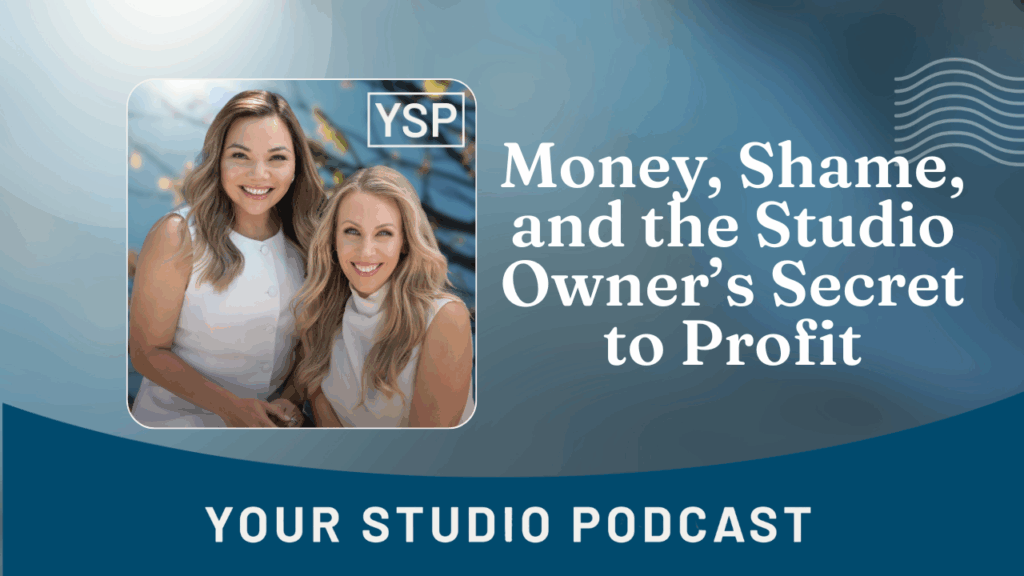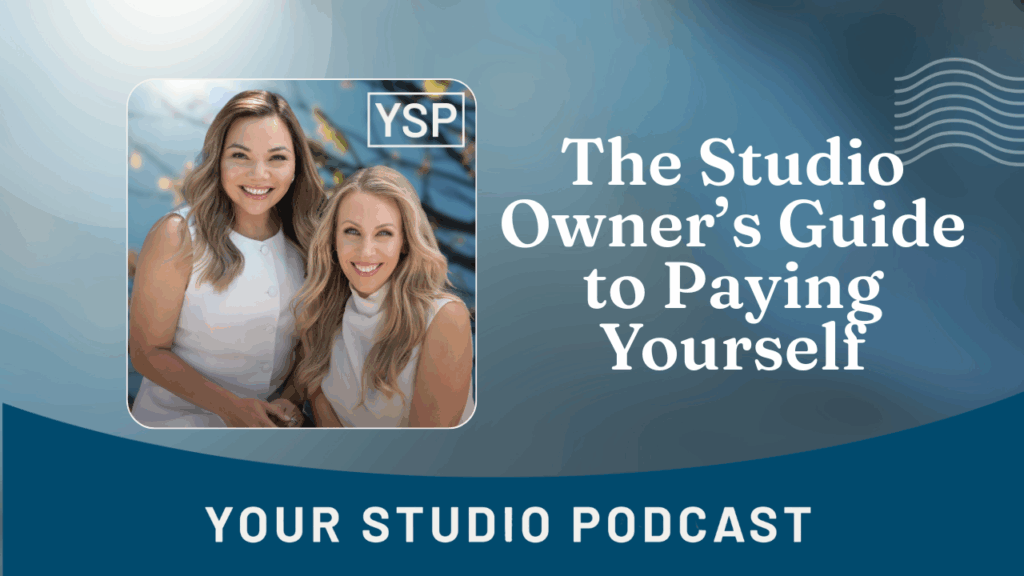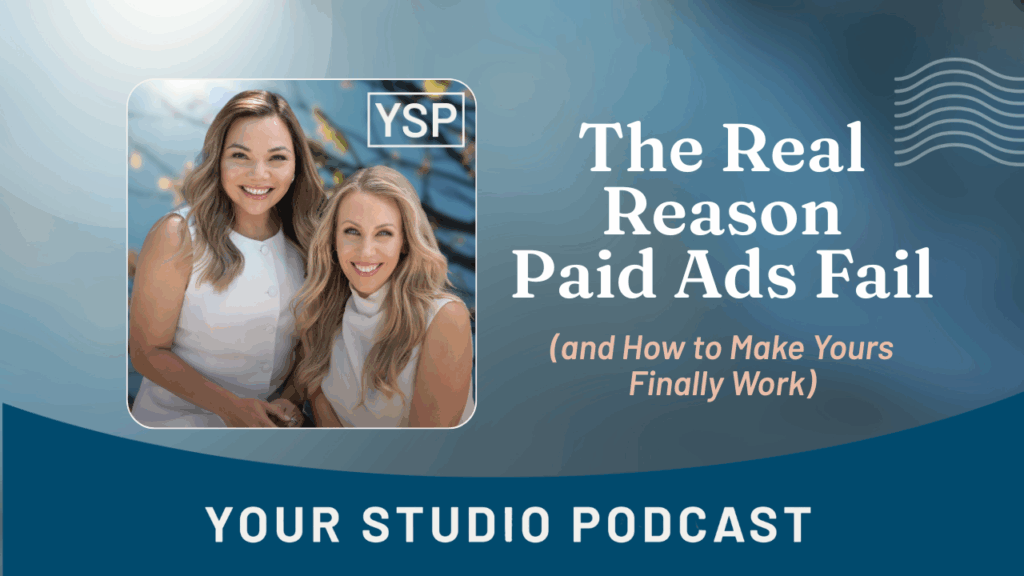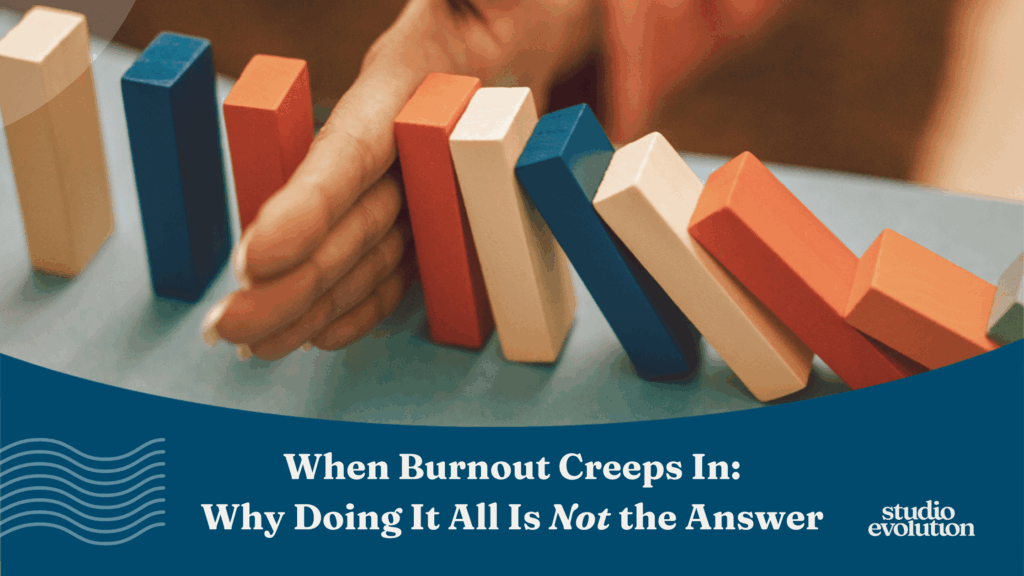Feeling nervous about raising your prices? You’re not alone. In this episode of Your Studio Podcast, Chantelle and Michelle unpack the fear so many studio owners feel when it comes to charging what they’re worth — and share the proven steps to raise your prices confidently, ethically, and without losing students. Tune in and discover how to create financial stability and freedom in your studio.
Please subscribe + review!
Voicemail: https://www.speakpipe.com/LeaveEvolutionAVoicemail
Instagram: @thestudioevolution
YouTube: @thestudioevolution
Facebook: @TheStudioEvolution
Website: studioevolution.com/start
Chantelle Bruinsma (00:04):
Welcome to Your Studio Podcast, sharing strategies for studio owners. I’m Chantelle Bruinsma here, with Michelle Hunter. And together we’re the CEOs of Studio Evolution, where for over a decade we’ve helped thousands of studio owners around the world of dance, music, acting art, yoga, and pilates studios transform their passion into thriving profitable businesses. So if you’re a studio owner, grab a cup of tea and settle in. You’re in exactly the right place.
Michelle Hunter (00:34):
Hello everybody and welcome back to Your Studio Podcast. It is Michelle Hunter here, and I’m here with my work wifey, Chantelle Bruinsma.
Chantelle Bruinsma (00:42):
Hello friends. How are you doing? How’s your day been? How are you? Like really? How are you?
Michelle Hunter (00:46):
Yeah.
Chantelle Bruinsma (00:47):
We are talking about doing scary things here on today’s episode, namely Raising your Prices. So I hope you’re sitting down. Yes, strap yourself in, get yourself a cup, and we’re going to go into the strategy behind price rising in raising your prices in your studio, and we’re going to teach you a bunch of stuff. And actually we’ve created a really cool resource that you could jump into after this call, which is going to be incredibly helpful for you. So stay tuned. But we’re just talking about for a lot of studio owners, raising your prices is one of the most terrifying, it will strike fear into the heart of studio owners is the idea of raising your prices, right?
Michelle Hunter (01:26):
And you’ll maybe delay this exercise in your business as long as possible for some of you because it is very confronting.
Chantelle Bruinsma (01:36):
Well, we had a beautiful client of ours, Michelle, at Elevate Retreat we had a few weeks ago, one of our Evolution members, and she had not raised her prices since before COVID, and you could tell this was paralyzed, right? Because of the fear of well families, I need to keep every family. I don’t want to kind of put a foot wrong. And so there’s this kind of feeling of tiptoeing in our own business and walking on eggshells to make everyone else comfortable and happy. Meanwhile, just the toll, the financial and energetic toll that that brings is really, really hard. So the purpose of today’s training is to give you a bit more education around the strategy of raising your prices and also how to do this in a way that feels as least scary as possible. Lemme put it that way. It feels kind of comfortable and you do it in a way that’s going to ensure you don’t lose students.
Michelle Hunter (02:26):
And it can be scary because it is confronting on so many levels on a communications level, managing your profitability and financial. So it can just be completely overwhelming. But Chantelle, it made me think about a time long, long ago, which we try to push out of our head good old, and we were faced with a really scary moment in our business.
Chantelle Bruinsma (02:53):
COVID was at its peak and we have usually we’ll be gone three times a year and they’re quite scheduled in advance, all planned, but COVID was burning the world down and everyone was freaking out. And we decided as a company that doing a launch at that time felt out of integrity. It felt kind of uncomfortable to us to be doing this big sales push when people were emotionally so beyond distress. And rightly so, Michelle, we decided to not do a launch, not do an intake in the Studio Evolution at this time. What we thought we’d do instead is we would just send an email out
Michelle Hunter (03:31):
Yeah.
Chantelle Bruinsma (03:31):
And what happened..
Michelle Hunter (03:34):
What happened is it went bonkers. So we decided not to do any Facebook ads, any posting or anything like that. And we just sent one email out telling them we’re not doing a big launch, but if you are interested, and we received a flurry Chantelle, we had people contacted us, us on dms and email, and we actually had our biggest enrolment ever to date in Studio Evolution.
Chantelle Bruinsma (04:01):
Yeah, I was eight and a half months pregnant, which is the least optimal time to have the biggest month of your life in your career. We made a million dollars that month in revenue. We would gain that revenue over a time, but it was our biggest month ever. And I’m there ready to pop and we’re still just all burning down. The world is burning down around us and it was really quite a weird moment in time. But it kind of goes to show that when you are faced with a time of you really want to honor the people around you
(04:35):
And you want to be respectful and you care about not putting pressure on people, the reason we’re telling this story is we didn’t want to do a launch because it felt it would be asking too much of people and we didn’t want to do that, right? We’re looking at ethical holistic sales here, but actually we tried to do so in a really respectful way and we were just staggered at the response. And sometimes doing that thing that is still honoring your worth and that still allows you to let people come and work with you in a way that is appropriate, can actually be the biggest win for your business. And that’s what raising your prices is all about. It’s about being consistent. And there is a really important piece of this conversation that is how much pricing relates to your positioning in the market. Now you can bet your bottom dollar that if someone moves to your area and they’re looking for a Pilates class or looking for a music class or they’re looking to pick up a dance class, something like that, they’re going to Google and they’re going to open all your competitors and they’re going to put them up on the tabs and they’re going to look down, they’re going to evaluate the different pricing.
(05:49):
Your pricing is going to send a message about your studio. And if your prices are low, if you are currently undercharging and you’re kind of below the average in your area, it does say a message. It does send communications on with your positioning. People’s perception is influenced by it. And you are there thinking, I want to be affordable. I want to make sure, I don’t want to charge too much, I don’t want to, who am I to charge this? But what they’re thinking when they see that is like this is maybe not a very good quality program. They might not have great resources. They maybe aren’t able to pay their team very much. They’re going to be thinking things which may actually be turning students away. And this is the tricky thing, right Michelle?
Michelle Hunter (06:39):
It is tricky and I think there’s a lot of self-worth tied into this as wealth pricing of who am I to charge this much money? But it is a direct link of how you are perceived in the marketplace and they’re doing a lot of researching now when the cost of living getting higher, they’re researching more than ever of the provider that they’re going to go with.
Chantelle Bruinsma (07:03):
But the reason that you’re probably not raising your prices is that you are scared that if you do, you’ll be seen as unattractive or inaccessible financially or that even more scary your current families will leave. So it’s this double-edged sword. We’re trying to keep our student our prices as low as possible for our students, but that’s actually having a reflection externally in the market as well. And then we, this is getting into, but then our prices aren’t quite high enough, which means that financially we’re strapped, which means we can’t reinvest back into the growth of the business. We can’t do advertising, we can’t get the website done. We can’t hire some team to support you doing your job to be able to give you more time to work on growing the business. This is where it’s that catch 22, raising your prices honestly is one of the greatest things you can do for your business across the board.
Michelle Hunter (07:55):
It really is. And I think there’s an important piece, Chantelle. It’s like the story we tell ourselves of the reaction to our students and our families when we raise prices to actually what happens can be totally different.
Chantelle Bruinsma (08:08):
Well, here’s my little rule of thumb. So whenever you raise your prices, there’s going to be people who don’t like it.
(08:20):
You are not a donut, okay? You’re not something that everyone loves. People are not going to be happy about it. But I’ll tell you in our minds, everyone is going to be so upset and there’s going to be a cue around the block of people with burning pitchforks and coming up after you with axes in their hands. No, that’s not what it’s going to be. Usually in my experience and experience with clients, it’s about 3% of people are going to give you feedback and feedback these days looks like a strongly worded email. So you can very, with tone.
(08:54):
A lot of tone and maybe some caps locks in there as well, Chantelle.
(08:57):
Maybe some caps, passive aggressive ship is going to be sent your way. So what I like to do is before you’re going to do a price rise, can you work out what 3% of your current student body is?
(09:10):
So if you’ve got 200 students, you can expect that you are going to get six very unhappy emails in your inbox. So expect them, welcome them. Ah, there we go. That’s number one. Good. Number two, where’s number two? Haven’t got that yet. Oh, good. It is number three. And usually it kind of sets you up to expect that people are going to give that feedback. Now the other thing with the price rise is that naturally this is going to create a bit of attrition. Some people are going to exit out, but if you follow the process that we teach you, it’s going to mitigate that. It’s going to reduce that risk. And here’s the thing, to calm your nervous system in this conversation. So by raising your prices, you are making more per student. So even if you lose a percentage of students, it usually actually works out. It usually actually works out. You are making more, but you are, you’ve lost a few. So you kind of at worst end up where you were usually with our clients, they end up better off is the truth. And then the compounding from then when you’re at a higher price point, bringing new students in just goes gross and gross and gross and gross. And that’s what you want, right, Michelle?
Michelle Hunter (10:25):
That’s exactly what you want. And when you do your first price rise successfully, or if you haven’t done one for a long time and do it, Chantelle, what do you say is the regularity of increasing your prices or finding this rhythm? It’s really hard because as an elevate, we had someone who hadn’t raised their prices since pre COVID, and that’s a common thing a lot of us studio owners we’re dealing with haven’t done a price rise in a really long time. So what is the right rhythm?
Chantelle Bruinsma (10:51):
The rhythm that I feel is the kindest and the least anxiety inducing is annual. When your students come to know and expect that every year there is a small price increase, it kind of takes the uncertainty out of it. Now, there’s a few things to really know in this pricing strategy that is important in terms of making sure we don’t lose students. The biggest thing, the biggest mistake studio owners make when it comes to raising their prices is that they do a price rise at the end of the year. At the end of the year when people are making a decision to return, oh, going forward from next year, our numbers are, our prices is this. So we are already at the highest retention risk time of the year, and then we’re kind chucking some fuel on the fire in their decision. The doors open and you’re like, here you go, off you go. And I’m like, don’t advise that. Please do not do a price rise for the year. What I really recommend is aligning your price rise with the financial year. Now, depending on where you are in the world here in Australia, the financial year starts in the 1st of July.
Michelle Hunter (12:07):
Yeah.
Chantelle Bruinsma (12:07):
You’re in the northern hemisphere, I can know America and I believe Canada, their financial year starts in the 1st of January. Now this is in the middle of our season, it’s in the middle of the academic year. Retention is more stable. It’s a calmer time, and it also is a very appropriate, it kind of aligns with the accounting timetable. No one is going to question it. So we send an email out four to six weeks prior and say, as of the 1st of July, as of the 1st of January in alignment with the start the new year, we’ll be raising our prices by to this dah, dah, dah. People come to know it. And this happens every year. That just means for you, it just happens. It’s just another thing on the calendar. There’s a price rise every 1st of July, really clean, right, Michelle? Takes the anxiety out.
Michelle Hunter (12:54):
It’s so clean. And would this be a great time to maybe eradicate things in your business or in your pricing that no longer serves you like sibling or discount pricing? Oh yes. Just do that too. Just do that too. I feel this is a thing. Back in the day that was huge. I’m not seeing as much of it, but I know that.
(13:13):
Oh, it’s there, hun. It’s there.
Chantelle Bruinsma (13:15):
So my bestie, Christine, who lives over the road, she’s got her kids at a studio, she’s got three kids, and she was telling me that what she spends in a year for her third child is essentially nothing. Essentially nothing. The discounting is so kind of strong. And I was like, oh, the studio owner hasn’t done Evolution yet, yet. But again, it’s that there is a real mentality of the more you do, the less you pay. And that can be true, but there has to be strategy around that. So that’s something to really sit with and explore. Again, this is our relationship with fear and being accepted or rejected. It’s kind of that tension between charging appropriately and feeling, I dunno if I am comfortable doing this, but when you are able to have a pricing model that supports the health and stability and profitability of a business, your life changes. And the way I think of it, that spot in that class, someone could be paying full price for that, and the quality of what you’re delivering is the same just because they’re a sibling. It’s no less work for you administratively or operationally or educationally to deliver.
Michelle Hunter (14:32):
The overheads are the same, it’s just that they’re same part of the family. Yeah.
(14:38):
Let’s talk about
Chantelle Bruinsma (14:39):
when our mate in our program who hadn’t raised their prices in a bunch of years. So in those cases, if you’re listening to this right now and in your heart that you are undercharging now, that may mean that when we are thinking about this price, price strategy for your business, we’re going to approach it a little bit differently because we have to do a bit of catch up. We have to do a little bit of recalibration to get you to an appropriate place. And you can do it like a bandaid.
Michelle Hunter (15:17):
That’s big.
Chantelle Bruinsma (15:18):
Yeah, I mean, I’ve had clients do it, to be honest. I mean, we had one client bought a rural studio.
Michelle Hunter (15:25):
Yes.
Chantelle Bruinsma (15:26):
Remember? And they had this real studio was kind of really undercharging but kind of solid base. They came in and tripled the price of the classes. So they must have been pretty damn low, low. And within 12 months they were at capacity. The studio was full. It was remarkable, remarkable growth because why? Let’s talk about why. What do you think the impression gave to the market?
Michelle Hunter (15:54):
Well, when they tripled their pricing, it’s a whole nother level of offering they’re bringing to the market.
Chantelle Bruinsma (16:00):
So everyone paid attention because oh, it’s kind of like you see a fancy car drive by like, oh, you spend a lot more, but you get a lot more and there’s prestige associated with it. So you can do it in a more assertive way. Probably what I’d recommend for your nervous systems is a little bit more of a structured approach
(16:22):
And we’d be looking to do a five-year price plan. So this is just sitting down one afternoon with a nice cup of tea, maybe a bit of chalky cake, and just actually thinking through, okay, right now this is what I’m charging at this year, and I know I probably need to be, you would work out what I like to call the vomit number. And here’s the vomit number. Your vomit number is if I called you and said, hi, I am looking to enrol in this class and you had to say the number, oh, no worries. It is X dollars per class saying that number would make bile rise in your throat. It would feel like that’s so much money, I don’t think I can justify charging that amount. Here’s the fun fact. You are going to end up charging that in time. That’s where because of inflation, because of how the world works in time, you’re going to charge it, right?
(17:19):
The timeframe of that is important that we kind of navigate, but I want to know what your vomit number is. I want to know for you, is it charging $25 a class? Is it charging $60 a class? What is the number that just makes you go, I can’t even imagine charging that amount or saying it. So we’d be kind thinking about at the five you for the year, 1, 2, 3, 4, 5, what we’re going to raise our prices to maybe just put the vomit numbers year five and then work backwards from there. So we’d be kind of wanting to prorate them out. So kind of think, okay, well I do need a bit of a stronger increase. So we are really undercharging here.
(17:56):
So maybe the first year we’re going to increase our prices by 10% and then maybe again, maybe the next year is a 5% increase, maybe the year after there’s another 10% increase just to kind of get us back to where we need to be. Again, this can take as long as you like. It can take as long as you like, but if you are undercharging, it’s going to need some confidence in how you approach this. It’s the only way to move by it. And by doing so, it does get you back into a competitive position. So if you are like undercharging and struggling with students, this is a marketing move. Friends, when you’re raising your prices, you were saying, we are the place to go. We are the best quality in town. We deliver superb quality of education and our pricing reflects it. You are worthy of charging well, you’re worthy of reflecting the quality of classroom experience they have, the transformation your students have. It reflects on the whole industry. You’re worthy of charging more friends. It’s important to do.
Michelle Hunter (18:55):
And gone are the days of the $5 $10 a class.
Chantelle Bruinsma (18:58):
Unfortunately, they’re not. I’d love to say that those days were done, but they’re not.
(19:04):
Then it still exists. But we would like them.
(19:07):
Well, because I believe that it’s very, very difficult to, those studios have got massive volume, but you know what else they’ve got massive churn. Massive churn. Yep. Churn and the retention’s usually shit. They’re getting kids in because it’s attractive, but they’re not keeping them and it’s not good business in my mind.
Michelle Hunter (19:31):
And that’s not good for the culture, and that’s not good for your profitability, stability.
Chantelle Bruinsma (19:37):
You can’t pay teachers well, you can’t pay your team well. And ethically for me, that’s a bit of an uncomfortable thing. I’d like to be able to, it’s important to me that you pay your teachers really well. In order to do that, you have to charge appropriately, and that’s an integrity thing. There’s no shame in that. Yeah, it’s time to kind of really help your studio be stable financially, which is going to support your marketing. It’s really, really good. So to help you all through this process, I’ve just created a How to Raise your Prices without Losing Students’ Guide. And this is a video series I recorded, I think maybe three or four videos that kind walks you through the process. I can’t even remember. It was a few weeks back. Recorded these videos, training you in each of these things in more depth so you can actually, I’ll guide you through the exercise of working through your five-year ping plan, calculating your vomit number, all of that, all those elements.
(20:32):
But then there’s something super duper fun that I’ve created to support this. So I’ve created a custom GBT, and it’s essentially, I have primed ChatGBT with my entire philosophy on pricing for studio owners. I have given examples of bad pricing examples and really good examples. And so I’ve primed this ChatGBT creation with examples of letters to send to your families, to your students of notifying them of a price price. I’ve given them examples of how to communicate this in the timeline and how to do mapping of the five-year pricing plan, like the increments to increase by. So literally everything I’ll be chatted about here today, you can put in your current pricing and it will chuck out everything that we’re seeking. It literally instantly generates in alignment with our philosophy and my kind of teaching approach for this. It’s going to go to generate for you in just seconds. It’s super fun. Now you can access this resource. I’d recommend you watch the videos first and then kind of afterwards jump into the GBT and give this a go for yourself. All you have to do is go to studioevolution.com/pricerise. You can jump in straight away, and it’s a really valuable way for you to get clarity on this. You don’t need to have anxiety around raising your prices. We just need a plan. And this resource is going to teach you everything you need to know, plus help create it in the GBT really quick smart.
Michelle Hunter (22:02):
Love it, quick smart. And what we know is that when you have a plan, you’re going to be able to deliver and roll this out with more confidence. And that’s what you want to do when you’re having a price rise. You want to be able to stand in your certainty of what you’re charging and also how you lovingly communicate this to your students and parents.
Chantelle Bruinsma (22:21):
Yeah, it’s safe for you to raise your pricing. It really is when you’ve got a really solid plan to do so. So we want to support you in feeling confident in raising your prices in a very stable and ethical and appropriate way. So go on head the studioevolution.com/pricerise, jump on in. Lemme know what you think.
(22:42):
Thanks so much for listening my friends, we’re very grateful to have you here and I can’t wait to hear how you going, what your vomit number is. I’m here for that. We’ll see you soon. Bye.
(22:51):
Bye.
(22:52):
Love what you’re hearing and want more. Make sure you subscribe so that you never miss an episode. And the good news is that we’ve pulled together a bundle of our most popular resources from marketing and retention to pricing and systems all in one place for you to binge inside. You’ll find videos, tools, and templates waiting for you. Everything you could need to start creating growth in your studio right now. All you got to do is visit studioevolution.com/start and dive on in.














